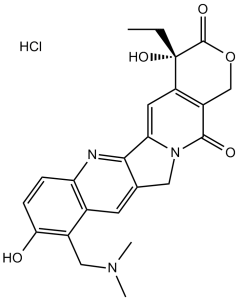Topotecan HCl (SKF 104864A)
This product is for research use only, not for human use. We do not sell to patients.

For small sizes, please check our retail website as below: www.invivochem.com
| Size | Price | Stock |
|---|---|---|
| 500mg | $150 | In Stock |
| 1g | $250 | In Stock |
| 5g | $750 | In Stock |
Cat #: V1392 CAS #: 119413-54-6 Purity ≥ 98%
Description: Topotecan HCl (formerly known as NSC609699, Nogitecan, NSC-609699, SKFS-104864A; trade name: Hycamtin), an FDA approved drug for cancer treatment, is a topoisomerase I inhibitor with potent antineoplastic activity.
Top Publications Citing Invivochem Products
Publications Citing InvivoChem Products
Product Promise

- Physicochemical and Storage Information
- Protocol
- Related Biological Data
- Stock Solution Preparation
- Quality Control Documentation
| Molecular Weight (MW) | 457.91 |
|---|---|
| Molecular Formula | C23H23N3O5.HCl |
| CAS No. | 119413-54-6 |
| Storage | -20℃ for 3 years in powder formr |
| -80℃ for 2 years in solvent | |
| Solubility In Vitro | DMSO: 92 mg/mL (200.9 mM)r |
| Water: <1 mg/mLr | |
| Ethanol: 92 mg/mL (200.9 mM) | |
| Solubility In Vivo | Saline: 30 mg/mL |
| Synonyms | NSC609699; SKF-104864-A; NSC 609699; SKF 104864 A; NSC-609699; SKF S104864A; Nogitecan HCl; SKFS 104864A; SKF104864A; TOPO. Hycamtamine; Hycamtin Hydrochloride; Nogitecan Hydrochloride; Topotecan; Nogitecan Hydrochloride; Trade name: Hycamtin. Chemical Name: (S)-10-((dimethylamino)methyl)-4-ethyl-4,9-dihydroxy-1H-pyrano[3',4':6,7]indolizino[1,2-b]quinoline-3,14(4H,12H)-dione hydrochloride SMILES Code: O=C1[C@](O)(CC)C2=C(CO1)C(N3CC4=CC5=C(CN(C)C)C(O)=CC=C5N=C4C3=C2)=O.[H]Cl |
| Protocol | In Vitro | Topotecan Hydrochloride (SKF 104864A Hydrochloride) obviously inhibits proliferation of not only human glioma cells but also glioma stem cells (GSCs) in a dose- and time-dependent manner. According to the IC50 values at 24 h, 3 μM of Topotecan Hydrochloride is selected as the optimal administration concentration. In addition, Topotecan Hydrochloride induces cell cycle arrest in G0/G1 and S phases and promoted apoptosis. Results show that the cell viability is inhibited by Topotecan Hydrochloride in a dose-dependent manner. 2, 20 and 40 μM of Topotecan Hydrochloride obviously inhibits the cell viability compared with the control groups. The IC50 values of Topotecan Hydrochloride at 24 h are 2.73±0.25 μM of U251 cells, 2.95±0.23 μM of U87 cells, 5.46±0.41 μM of GSCs-U251 and 5.95±0.24 μM of GSCs-U87. Thus 3 μM of Topotecan Hydrochloride is selected as the optimal administration concentration in the subsequent experiments |
|---|
These protocols are for reference only. InvivoChem does not
independently validate these methods.
| Solvent volume to be added | Mass (the weight of a compound) | |||
|---|---|---|---|---|
| Mother liquor concentration | 1mg | 5mg | 10mg | 20mg |
| 1mM | 2.1838 mL | 10.9192 mL | 21.8384 mL | 43.6767 mL |
| 5mM | 0.4368 mL | 2.1838 mL | 4.3677 mL | 8.7353 mL |
| 10mM | 0.2184 mL | 1.0919 mL | 2.1838 mL | 4.3677 mL |
| 20mM | 0.1092 mL | 0.5460 mL | 1.0919 mL | 2.1838 mL |
The molarity calculator equation
Mass(g) = Concentration(mol/L) × Volume(L) × Molecular Weight(g/mol)
Mass
=
Concentration
×
Volume
×
Molecular Weight*
The dilution calculator equation
Concentration(start)
×
Volume(start)
=
Concentration(final)
×
Volume(final)
This equation is commonly abbreviated as: C1 V1 = C2 V2
Concentration(start)
C1
×
Volume(start)
V1
=
Concentration(final)
C2
×
Volume(final)
V2
Step One: Enter information below
Dosage mg/kg
Average weight of animals g
Dosing volume per animal µL
Number of animals
Step Two: Enter the in vivo formulation
%DMSO
+
%
+
%Tween 80
+
%ddH2O
Calculation Results:
Working concentration:
mg/ml;
Method for preparing DMSO master liquid:
mg
drug pre-dissolved in
µL
DMSO(Master liquid concentration
mg/mL)
,Please contact us first if the concentration exceeds the DMSO solubility of the batch of drug.
Method for preparing in vivo formulation:
Take
µL
DMSO master liquid, next add
µL
PEG300, mix and clarify, next add
µL
Tween 80,mix and clarify, next add
µL
ddH2O,mix and clarify.
Note:
- (1) Please be sure that the solution is clear before the addition of next solvent. Dissolution methods like vortex, ultrasound or warming and heat may be used to aid dissolving.
- (2) Be sure to add the solvent(s) in order.




































